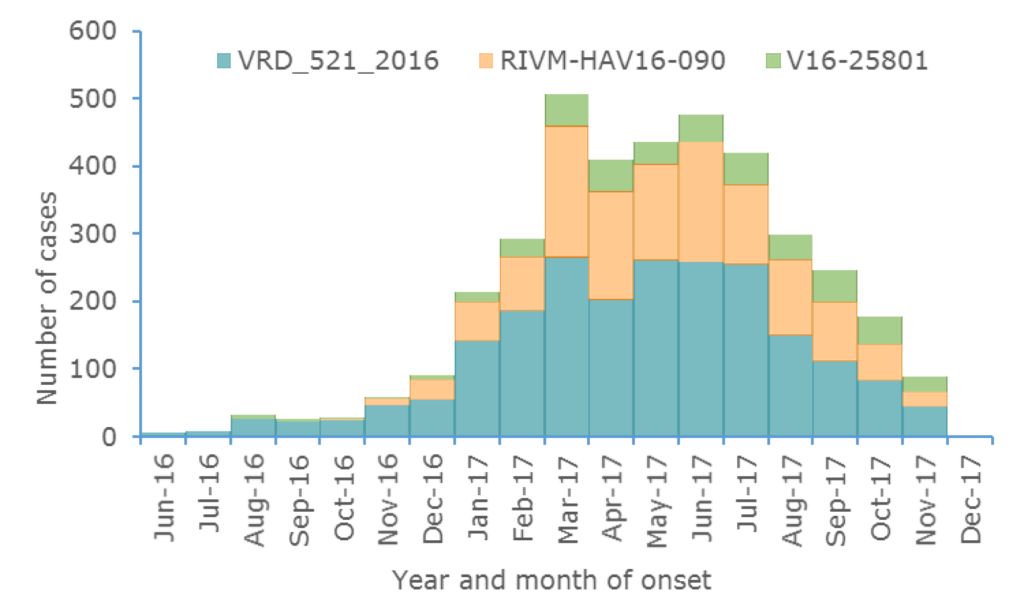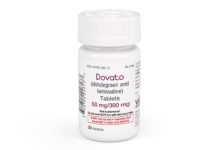Since the last epidemiological update on this multi-country hepatitis A outbreak published on 29 September 2017, 22 EU/EEA countries (Austria, Belgium, Croatia, the Czech Republic, Denmark, Estonia, Finland, France, Germany, Greece, Ireland, Italy, Latvia, Luxembourg, Malta, the Netherlands, Norway, Portugal, Slovenia, Spain, Sweden and the United Kingdom-England & Wales) have reported 950 new outbreak-confirmed cases. Outbreak-confirmed cases are EU/EEA residents with laboratory-confirmed hepatitis A virus (HAV) genotype IA and a sequence with ≥99.3% homology to one of the three HAV genotype IA outbreak strains (VRD_521_2016; RIVM-HAV16-090; and V16-25801) based on overlapping fragments at the VP1-2a region.
As of 18 December 2017, the number of outbreak-confirmed cases reported in the 22 reporting countries since 1 June 2016 is 3 813 (Figure 1). For 3 781 of these cases, information on gender is available, with a male-to-female (M/F) ratio of 6.8; a sharp reduction from the M/F ratio observed in September which was 9.3. No other strains have been reported to be widely circulating among men who have sex with men (MSM) apart from the three outbreak strains and their close variants, which are captured in Figure 1.
Figure 1. Distribution of hepatitis A outbreak-confirmed cases, by month of onset and genetic sequence, June 2016 to December 2017, as of 12 December 2017, EU/EEA (n=3 813*)

Figure 1. Distribution of hepatitis A outbreak-confirmed cases, by month of onset and genetic sequence, June 2016 to December 2017, as of 12 December 2017
* Where date of onset was unavailable we used date of sampling or date of receipt by the reference laboratory
Countries included: Austria, Belgium, Croatia, the Czech Republic, Denmark, Estonia, Finland, France, Germany, Greece, Ireland, Italy, Latvia, Luxembourg, Malta, the Netherlands, Norway, Portugal, Slovenia, Spain, Sweden and the United Kingdom.
Outbreak-confirmed cases for Scotland are reported until June 2017.
The month with the largest number of outbreak-confirmed cases was March 2017 with 507 cases. There may be substantial reporting delays (weeks or even months) in sequencing information and the number of cases with onset in more recent months is likely to increase once more sequencing results are available.
Outbreak-confirmed cases provide an underestimation of the true extent of the outbreak. This is because sequencing information is only available for a proportion of hepatitis A cases as sampling strategies vary widely from country to country, and they also varied during the different phases of the outbreak. In 2017, 1 792 (56%) of the 3 223 laboratory-confirmed hepatitis A case strains in 17 EU/EEA countries (Austria, Belgium, Croatia, Denmark, Estonia, Greece, Finland, Ireland, Latvia, Luxembourg, Malta, the Netherlands, Norway, Portugal, Slovenia, Sweden and the United Kingdom) were sequenced. Of these 1 792 sequenced cases, 1 388 (77%) were infected with one of the outbreak strains.
In order to better define the extent of this outbreak, we describe all hepatitis A laboratory-confirmed cases, with or without information on genetic sequence, and the related male-to-female ratio. From January to November 2017, 24 countries (the 22 mentioned above, plus Iceland and Lithuania) reported 15 040 laboratory confirmed cases with an overall M/F gender ratio of 3.6. The highest M/F ratio was 4.9, reported in March 2017. Since then, the number of male cases decreased progressively until November 2017 when the M/F ratio was 2.0 (Figure 2).
The 15 040 hepatitis A cases reported by the 24 countries from January to November 2017 represent an almost four-fold increase compared to the average 4 226 cases reported for the same period between 2012 and 2015. The year 2016 was excluded from the comparison as the current outbreak was already underway at the time.
Information on gender is available for 15 022 cases: 11 790 males and 3 232 females. Compared to the average number of hepatitis A cases reported during the same period between 2012 and 2015, the number of male cases increased by 606% and the number of female cases increased by 87%.
Figure 2. Distribution of hepatitis A cases by gender and male-to-female ratio, January 2012 to November 2017, as of 16 December 2017, EU/EEA*

Figure 2. Distribution of hepatitis A cases by gender and male-to-female ratio, January 2012 to November 2017
* Where date of onset was unavailable we used date of sampling or date of receipt by the reference laboratory. The 2017 data from the United Kingdom are only for England and Wales. Data from Belgium are missing for 2015 and 2016. Countries included: Austria, Belgium, the Czech Republic, Denmark, Croatia, Estonia, Finland, France, Germany, Greece, Ireland, Iceland, Italy, Latvia, Lithuania, Luxembourg, Malta, the Netherlands, Norway, Portugal, Slovenia, Spain, Sweden and the United Kingdom.
In addition, as of 14 November 2017, Poland reported an increase in hepatitis A cases for which information on gender was not available. Between January and October 2017 there were 2 206 hepatitis A cases, compared to 26 cases during the same period in 2016. This represents an 85-fold increase in cases during 2017 compared to 2016 for this country.
Slovakia did not report cases in 2017 for this epidemiological update, but ECDC epidemic intelligence screening identified 503 hepatitis A cases in the country between January and October 2017, compared to 1 157 cases during the same period in 2016 – a two-fold decrease. However, in Poland and Slovakia no cases could be linked to the current outbreak since sequencing information was not available.
ECDC asked EU/EEA countries to report on events that could contribute to the spread of the outbreak strains in population groups at increased risk of infection or in the community. As a result of these spill-over events, a limited increase has been noted in females, children and the elderly in parallel with the large increase in male cases. Since the last epidemiological update, Austria, France, Italy and the Netherlands have reported an increase in females to a greater or lesser extent. In the Netherlands 33% of hepatitis A cases in females were infected with one of the outbreak strains. The Czech Republic, France and Italy reported an increase in children, and France and Italy also reported an increase in the elderly. Since the last epidemiological update, Germany has reported a small food-borne outbreak of hepatitis A involving a food handler.
Publications describing the characteristics of cases in Denmark , France , Germany , Malta , the Netherlands and Spain are available online.
Vaccination
The main prevention measure in this context is hepatitis A vaccination of MSM and their close contacts. Hepatitis A vaccine availability in the EU is currently limited, with some countries reporting shortages, including Austria, Denmark, Greece, Italy, Malta, Portugal and Spain. On the other hand, Belgium, Croatia, Estonia, Finland, Iceland, Ireland, Luxembourg and Slovenia have not reported any shortages.
In addition, since the last update, vaccine shortages have been reported in the Czech Republic, France and Norway and minor shortages have been reported in Germany, while Lithuania has not reported any shortages. The Netherlands and Sweden have reported no shortages compared to the previous ECDC update in which they reported some shortages.
It is suggested that vaccination can be promoted and offered to MSM attending Pride festivals, where there may be an increased likelihood of contact with hepatitis A-infected individuals. However, limited hepatitis A vaccine availability in some countries may hinder the implementation of these measures.
Since the last ECDC rapid risk assessment in June 2017, Austria , Denmark , France , Italy , Norway , Spain and the United Kingdom have issued new vaccination recommendations.
Assessment
Between June 2016 and November 2017, 22 EU/EEA countries reported 3 813 hepatitis A outbreak-confirmed cases associated with this outbreak that peaked in March 2017.
In addition, since January 2017, 15 040 hepatitis A laboratory-confirmed cases were notified by 24 EU/EEA countries that peaked in June 2017, while the highest M/F ratio was observed in March 2017. As of 18 December 2017, the monthly number of laboratory-confirmed cases remain significantly higher than in previous years. The M/F ratio
has significantly decreased in the recent months but remains higher than in previous years.
A considerable increase in the total number of hepatitis A cases in women has also been observed, with outbreak strains circulating in this group too. This indicates that the outbreak has spilled over to the non-MSM population.
Although decreasing in its intensity, the outbreak is still ongoing and more cases associated with this event are to be expected in EU/EEA countries in the coming months.
The conclusions and options for response set out in ECDC’s rapid risk assessment entitled ‘Hepatitis A outbreak in the EU/EEA mostly affecting men who have sex with men – Third update, 28 June 2017’, remain valid.


 ПОИСК ПО САЙТУ
ПОИСК ПО САЙТУ  поиск по ресурсному центру
поиск по ресурсному центру 



